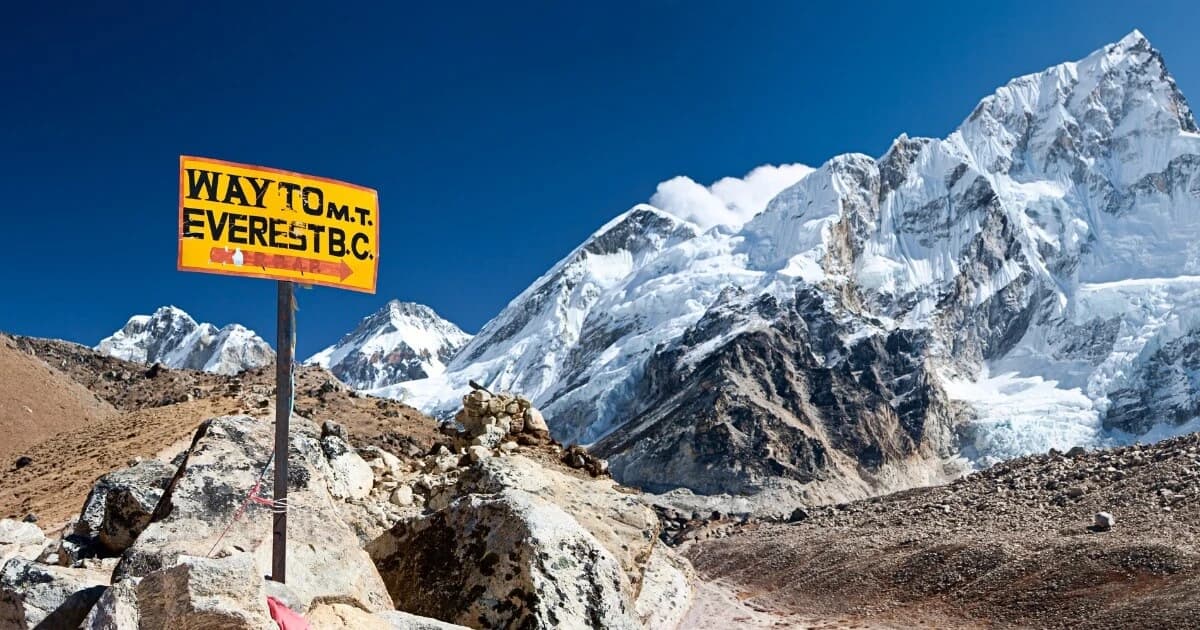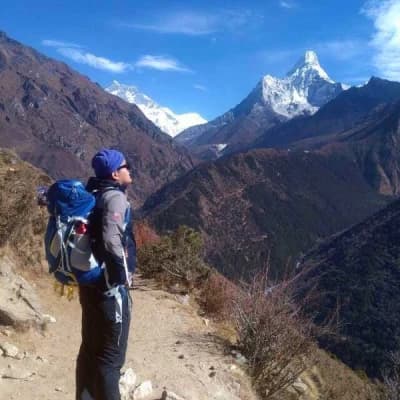Everest Base Camp Trek offers unique experiences in different seasons. However, the best time to visit the Everest Base Camp is during peak season (Spring-Autumn). The weather and temperature at Everest Base Camp are comfortable during this season.
Have you dreamt of reaching the foot of the mighty Everest? Months of planning and preparation lead to this epic adventure at Everest Base Camp. But navigating the Everest Base Camp seasons can be tricky. This blog includes the best time of the year to visit Everest Base Camp. We tell you the secrets of each season, helping you choose the best time to visit Everest Base Camp.
While March to May and September to November are widely known as the “best” months, the ideal season depends on your preferences and desired experiences.
Trek to Everest Base Camp depends on the Everest Base Camp’s monthly temperature. Spring (March-May) and autumn (September–November) are peak times.
Everest Base Camp in March offers mild temperatures, crystal-clear skies, and landscapes covered with rhododendrons. Sounds pretty tempting, right? But Everest Base Camp in May is perfect for warm, sunny days and comfortable temperatures.
While spring and autumn may dominate the headlines for Everest Base Camp (EBC), the off-peak month to trek can also unlock a magical experience. Winter is the worst time to climb Mount Everest, but the monsoon (June-August) offers a lush green landscape bursting with life and waterfalls.
Peak Time to Visit Everest Base Camp

1. Spring (Mid March-May)
Springtime, which blossoms between mid-March and May, paints the Everest Base Camp (EBC) trek in breathtaking colors and welcomes trekkers with open arms. It is the golden season for conquering the mighty Everest.
- During the spring, temperatures are mild, ranging from a comfortable 5°C to 15°C, making every step enjoyable. Spring seasons offer clear skies and undisrupted views of the majestic peak.
- The weather conditions during spring might be sunny, and you might encounter occasional rain or snowfall, especially at higher altitudes. Be prepared for these changes in weather by packing proper rain gear and warm layers. And remember, unforeseen weather conditions can sometimes lead to trail closures, so flexibility is key.
2. Autumn (Late September to November)
With summer’s warmth fading and winter’s chill yet to arrive, autumn (late September to November) has much to offer. The Everest Base Camp (EBC) trek in autumn is filled with vibrant colors and refreshing air.
- Early autumn (September–October) offers warmer days, while late November brings cooler temperatures and the possibility of snowfall at higher altitudes.
- Autumn balances pleasant temperatures (6°C to 22°C) and breathtaking scenery, making it a popular choice for many trekkers. Pack accordingly, depending on your chosen timeframe.
Off Peak Months to Visit Everest Base Camp
1. Winter (December to February)
Everest Base Camp (EBC) in winter, from December to February, presents a unique and challenging experience for intrepid adventurers. Unlike the bustling spring and autumn seasons, winter offers untouched landscaping and a different perspective on the majestic Himalayas. But be prepared, for it’s a season of extreme temperatures, potential challenges, and a unique beauty brand.
- Weather and temperature in winter brace you for ranges from -15°C to -25°C at night and even dipping below -30°C in higher altitudes. Days are generally sunny and clear, offering stunning views, but the wind chill makes it feel much colder.
- Off-season discounts on flights, accommodations, and permits can entice budget-conscious travelers.
Read Also:
2. Monsoon (June to August)
The monsoon season starts from June to August, and the Everest Base Camp (EBC) trek is painted lush green with waterfalls around every corner. But be prepared; this season comes with its own set of challenges and rewards.
- Weather and temperature during the Monsoon season offer frequent rainfall, often occurring in the afternoons and evenings. Expect humid conditions, especially at lower altitudes, with temperatures ranging from 10°C to 15°C during the day and dropping to 2°C at night.
- Landslides and trail closures are possible due to heavy rain. Capture stunning photos of the contrasting beauty of rain-washed peaks and lush vegetation. Slippery trails, potential landslides, and limited visibility due to rain and fog can make the trek more demanding. Be prepared for physical exertion and potential delays.
Know More on the Best Time To Visit Everest Base Camp Trek
Is it worth trekking to EBC?
Whether or not you should trek to Everest Base Camp (EBC) depends entirely on your preferences and priorities. It’s an incredible accomplishment and offers
stunning scenery and cultural immersion. However, it also demands physical fitness, requires significant preparation, and can be expensive.
The EBC trek is challenging, involving long days of hiking at altitude. You must be in good physical condition to complete it safely and enjoyably. The trek typically takes 15- 18 days, so you must dedicate significant time to it.
As you ascend, the Himalayas unfold before you. Witness Jagged peaks, snow-capped giants, and glacier-carved valleys create awe-inspiring views. Witness the sun painting the snow-capped peaks in pink, orange, and purple at dawn and dusk. These mesmerizing moments are worth waking up too early in the mornings and chilly evenings.
Remember, the views change with the seasons. Spring offers blooming rhododendrons, while winter’s snow-covered landscape has its charm. Monsoon might reveal cascading waterfalls, while autumn boasts clear skies and vibrant golden hues.
How can you prepare for the EBC trek?
Everest Base Camp (EBC) is a dream adventure for many trekkers, but preparation is key to a safe and enjoyable experience.
- Do some physical fitness or cardio before your trip to Everest Base Camp begins. It helps build your endurance with running, walking, or cycling. Remember to focus on leg muscles (squats, lunges) and core (planks, sit-ups) for carrying a backpack and tackling inclines.
- Invest in high-quality gear and equipment, such as clothes and shoes—pack layers for varying temperatures and weather conditions. Choose moisture-wicking materials for breathability and quick drying.
- Invest in good hiking boots and socks to prevent blisters. Essential items include a sleeping bag rated for cold temperatures, trekking poles, a headlamp, water purification tablets, a first-aid kit, and sunscreen.
- Travel insurance is the most essential thing for every trekker. Permits and necessary documents are also important and must be carried wherever you wind up. Obtain your trekking license well in advance and consider travel insurance for medical emergencies or trip disruptions.
Can a beginner do an EBC trek?

Whether or not you are a beginner, you can do the Everest Base Camp (EBC) trek. While it’s not technically a climb and doesn’t require specific mountaineering skills, it’s still a physically demanding journey.
Altitude can be a challenge for beginners or even some experienced trekkers. The highest point on the trek to Everest base camp is Gorakshep (5,364m), where oxygen levels are significantly lower than at sea level. Beginners can find it challenging to adjust to sudden changes in altitude and experience altitude sickness. However, proper acclimatization and physical fitness can make a trek to Everest Base Camp more comfortable for beginners.
As a beginner, you can choose an alternative route or shorter treks like Everest View Trek or Gokyo Ri. These routes offer stunning views without reaching the full EBC altitude. For a better hiking experience, hire a guide and ascend gradually.
Can you solo Everest Base Camp?
In the past, solo trekking to Everest was possible in the Everest Region. Still, recently on April 1, 2023, solo trekking is no longer allowed in Nepal’s national parks and conservation areas, including the area encompassing Everest Base Camp (EBC). This regulation applies to all trekkers, regardless of experience or ability. Therefore, you must have a licensed trekking guide to trek to the EBC. This rule prioritizes your safety and well-being.
Altitude Sickness can be a major problem for solo trekkers, especially during the winter and monsoon season. A guide can monitor your condition and help prevent or manage altitude sickness.
The trails may not be well-marked, especially in higher sections. A guide can ensure you stay on the right path and avoid getting lost. If you encounter an injury, illness, or unexpected situation, having a guide significantly increases your chances of receiving timely assistance. A guide can provide valuable insights into local customs and traditions, enhancing your cultural experience.
Recommended Read: Can I Trek on My Own?
Final Thoughts
The best times to visit Everest Base Camp are during the peak seasons of Spring (March to May) and Autumn (September to November). Regardless of the season, proper preparation is essential for a safe and enjoyable trek. Hiring a licensed trekking guide ensures compliance with regulations and enhances the overall experience by providing invaluable support, insights, and assistance along the journey. At Tidy Himalaya, we are committed to facilitating unforgettable adventures to Everest Base Camp and beyond.


.webp&w=1200&q=75&dpl=dpl_2PwU5ZDv8uoJ3KrzEVbz8N547HgX)
.webp&w=1200&q=75&dpl=dpl_2PwU5ZDv8uoJ3KrzEVbz8N547HgX)
.webp&w=1200&q=75&dpl=dpl_2PwU5ZDv8uoJ3KrzEVbz8N547HgX)